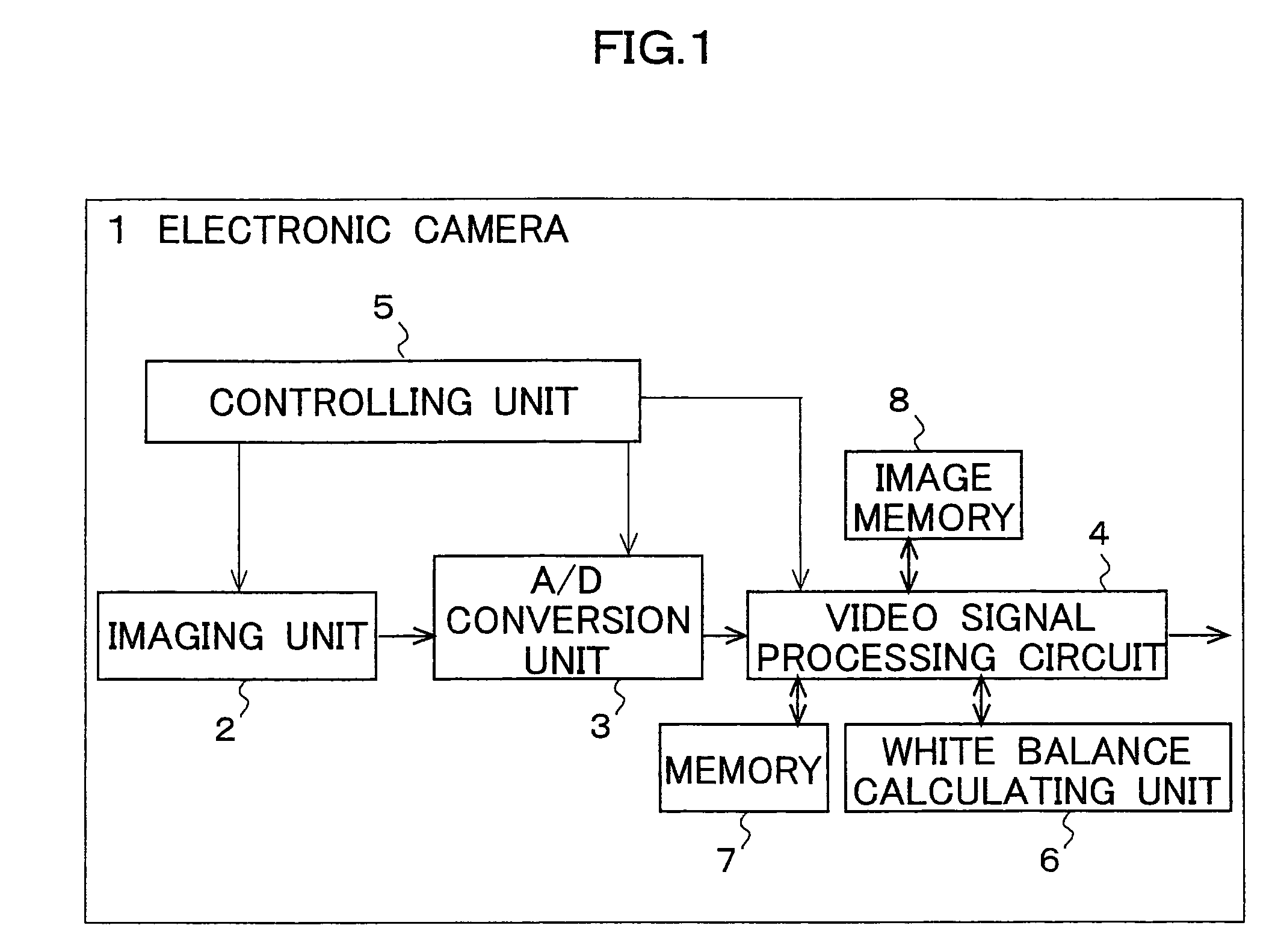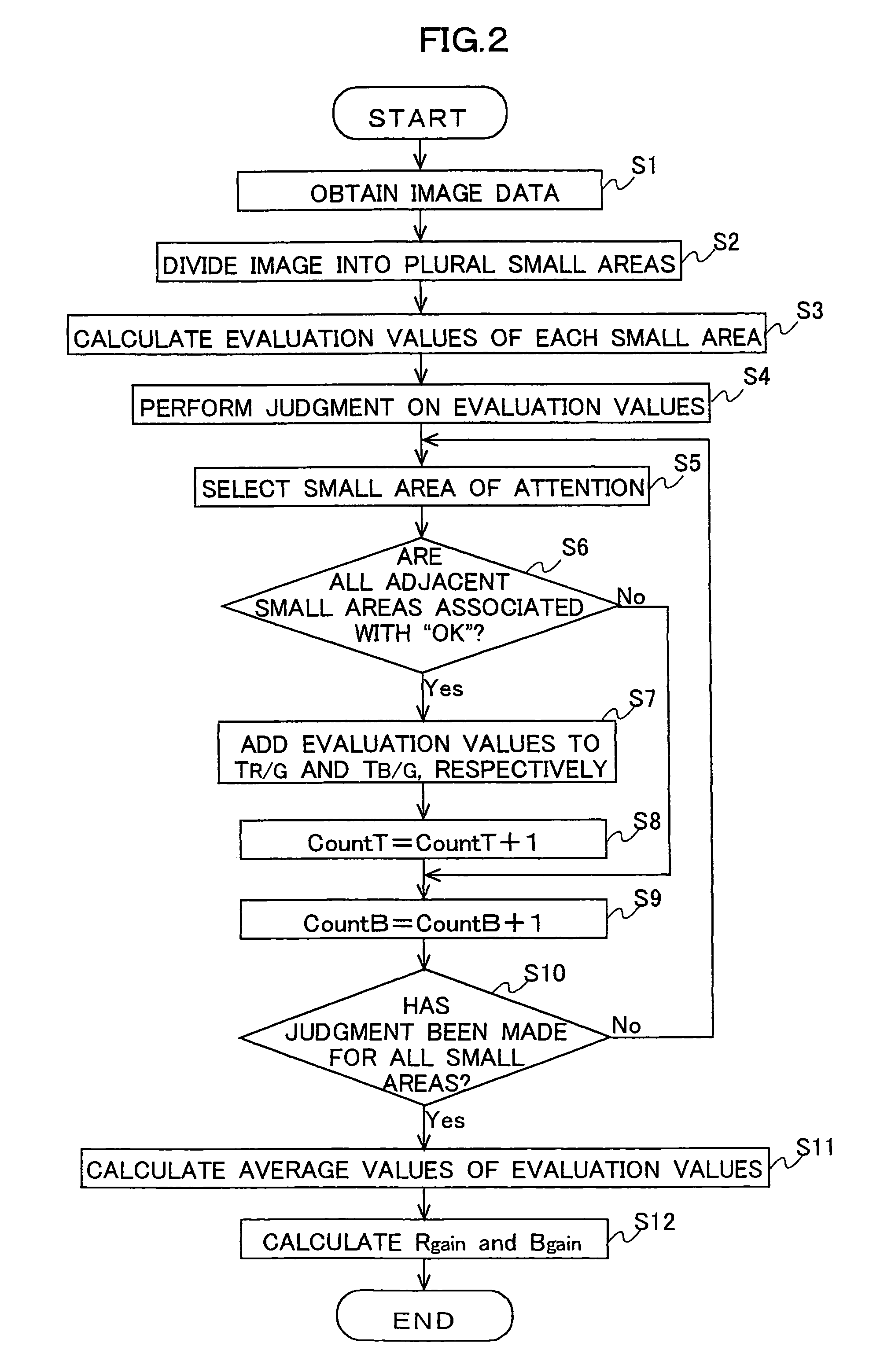White balance adjusting device, imaging apparatus, and recording medium storing white balance adjusting program
a technology of white balance adjustment and imaging apparatus, applied in the field of imaging apparatus and white balance adjustment program, can solve the problems of inability to accommodate and improper white balance adjustment, and achieve the effect of suppressing color failur
- Summary
- Abstract
- Description
- Claims
- Application Information
AI Technical Summary
Benefits of technology
Problems solved by technology
Method used
Image
Examples
first embodiment
[0027]A first embodiment will be described below with reference to the drawings. The first embodiment is directed to an electronic camera which is equipped with a white balance adjusting device according to the present embodiment.
[0028]FIG. 1 is a functional block diagram of an electronic camera 1 according to the first embodiment. As illustrated in FIG. 1, the electronic camera 1 is equipped with an imaging unit 2, an A / D conversion unit 3, a video signal processing circuit 4, and a controlling unit 5 for controlling the individual units. Equipped with an imaging lens (not illustrated), an imaging device, etc., the imaging unit 2 generates an image signal by taking an image of an object and outputs it to the A / D conversion unit 3. The A / D conversion unit 3 generates digital image data based on the received image signal and outputs it to the video signal processing circuit 4. The electronic camera 1 is also equipped with a white balance calculating unit (hereinafter referred to as “...
second embodiment
[0049]A second embodiment will be described below with reference to the drawings. The second embodiment is a modification of the first embodiment. In the second embodiment, only components, operations, etc. that are different than in the first embodiment will be described in detail with components having the same components in the first embodiment given the same reference symbols as the latter.
[0050]The second embodiment is directed to an electronic camera which is the same in configuration as the electronic camera 1 of FIG. 1 according to the first embodiment.
[0051]FIGS. 7 and 8 are a flowchart of a process which is executed by the WB calculating unit 6 at the time of white balance adjustment.
[0052]At steps S21-S25, the WB calculating unit 6 performs the same processing as at steps S1-S5 in FIG. 2.
[0053]At step S26, as at step S6 in FIG. 2, the WB calculating unit 6 judges whether or not all the small areas (i.e., eight small areas) adjacent to the small area selected at step S25 a...
third embodiment
[0066]A third embodiment will be described below with reference to the drawings. The third embodiment is a modification of the first and second embodiments. In the third embodiment, only components, operations, etc. that are different than in the first and second embodiments will be described in detail with components having the same components in the first and second embodiments given the same reference symbols as the latter.
[0067]The third embodiment is directed to an electronic camera which is the same in configuration as the electronic camera 1 of FIG. 1 according to the first embodiment.
[0068]FIGS. 10 and 11 are a flowchart of a process which is executed by the WB calculating 110 unit 6 at the time of white balance adjustment.
[0069]At steps S41-S45, the WB calculating unit 6 performs the same processing as at steps S1-S5 in FIG. 2.
[0070]At step S46, as at step S6 in FIG. 2, the WB calculating unit 6 judges whether or not all the small areas (i.e., eight small areas) adjacent to...
PUM
 Login to View More
Login to View More Abstract
Description
Claims
Application Information
 Login to View More
Login to View More - R&D
- Intellectual Property
- Life Sciences
- Materials
- Tech Scout
- Unparalleled Data Quality
- Higher Quality Content
- 60% Fewer Hallucinations
Browse by: Latest US Patents, China's latest patents, Technical Efficacy Thesaurus, Application Domain, Technology Topic, Popular Technical Reports.
© 2025 PatSnap. All rights reserved.Legal|Privacy policy|Modern Slavery Act Transparency Statement|Sitemap|About US| Contact US: help@patsnap.com



